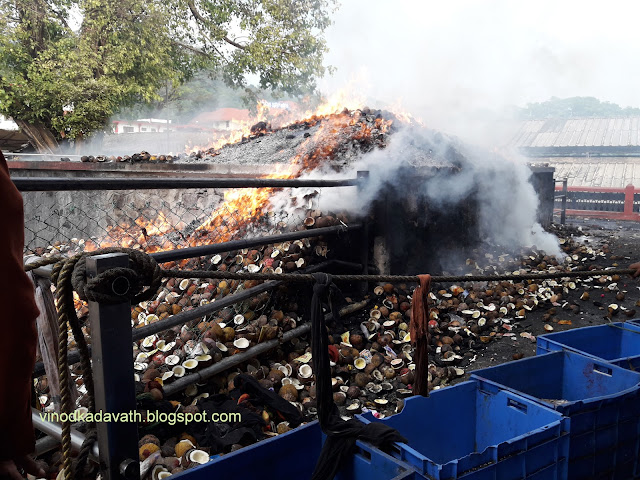Situated on a hilltop (about 3000 feet above sea level) named Sabarimala ( Mount Sabari) in Pathanamthitta district, in the Indian state of Kerala, the temple dedicated to Lord Ayyappa is known as Sabarimala Sree Ayyappaswamy Temple. Sabarimala lies in the Sahyadris, the Western Ghats.
KETTUNIRA
Wearing the holy Mala and black clothes, I reached the temple for Kettunira - preparation of the travel kit (irumudi kettu). Without the irumudi, the devotees are not allowed to climb the 'pathinettaam padi' (18 steps) at the Sannidhanam.
The irumudi kettu has twin pockets. The pooja articles and offerings to Lord Ayyappa are placed in this kit. There are minimum three coconuts in this kit. The first coconut is to be broken at the Pampa Ganapati Temple, the second at Pathinettam Padi and the third one is used to fill ghee.( A coconut is cleaned and polished and a hole is made on one eye of the coconut, emptying the water inside. Ghee is filled inside this coconut).
After completing the Kettunira for all the group members, the Guruswami placed the 'irumudikettu' on our head.
THE JOURNEY STARTS
And the journey starts with chanting Saranam. There are three routes to reach Sabarimala. Our route was Erumeli->Pampa->Sabarimala. Erumeli is the most popular route to the shrine. Legend says that Ayyappa himself followed this path to the summit of the hill. It is also the most arduous route - 61 kms through the forested hills.
Day 2:
At around 2 AM, we reached Erumeli Temple.
 |
Add caption
|
You can watch or participate in the famous Erumeli Petta Thullal. The devotees paint themselves with colors and carry tree branches, odd-looking arrows etc. and dance with drum and chants 'Ayyappa thinthaka thom, Swami thinthaka thom'.
There are two other shrines adjacent to the main temple at Erumeli - one for Lord Ayyappa and the other one dedicated to Vavar Swamy- the Muslim aide of Lord Ayyappa.
Devotees usually visit the shrine dedicated to Vavar on the way to Sabarimala.
JUNGLE WALK
You can either walk till Mukkoshi temple or take a private vehicle to reach there. The trek through the dense forest (Periyar Tiger Reserve) starts from here.
 |
Add caption
|
This dense forest area till Pampa river is known as Poongavanam.
The Devaswam Board has arranged several resting places( Thavalam) at regular intervals. There are three thavalam' s in between - Vallaramchetta, Puthussery and Karimala. Devotees can take rest or have food and drinks like water, butter-milk, cool drinks etc etc.
The next stop was Kariyilam thodu and we took rest here for sometime. Karimala trek starts from this place. It was an absolutely memorable experience to walk through the dense forests chanting Saranam.
On the top of Karimala, resting facility is available for pilgrims. After taking rest and burning camphor for Karimala Nathan, we started descending the Karimala.
PAMPA
After crossing Karimala, we reached Pamba river via Cheriyanavattom and Valliyanavattom. Upon reaching Pampa, a bath at Pampa river was refreshing. Also considered as sacred as the Ganga up north, devotees believe that a dip in the river can wash away all the sins of a lifetime.

There are accommodation options, restaurants, tea shops etc in Pampa.
Day 3:
Woke up early in the morning, had a bath in Pampa river before starting our journey to Sannidhanam. We visited Ganpati temple beside Pampa river and broke one of the coconuts. Then started our trek through the steep mountain path of Neeli Mala till Sabari Mala. En route emergency shops, medical aid, refreshing facility etc are provided. Since this is a steep slope, devotees are advised to go slowly and take some rest in between.
There are Dholis available for those who cannot climb the steep hill. It is a bamboo chair and four men will carry a person who is seated on the chair. Soon we reached Marakoottam stop, from which the queue got restricted.
After crossing Saramkuthi stop , we reached Sannidhanam Nadapanthal. There was a long queue in many layers.
After standing in the queue for almost 4 hours, we climbed the 18 sacred steps in the main stairway to the temple. The shrines of Malikappurath Amma, Kannimoola Ganapathi , Lord of snakes-Nagaraja are also there in the Sannidhanam.
 |
| Sannidhanam |
The ghee from the filled coconut is offered as abhisekham to the Lord. After having darshan of the Lord, I came out of the temple with blessings of the Supreme Lord. You can offer other pooja items to other shrines. The broken ghee coconut (Neythenga) is then offered to the fireplace (Azhi).
 |
| Aazhi, Sabarimala |
Annadhanam ( a sacred tradition of offering food ) was available in a hall outside the temple.
PRASADAM
Bought Aravana payasam and Appam - the main prasadam of Sabarimala temple.
Soon we started our return journey with a spiritually fulfilling experience. One should visit this temple at least once in their lifetime.
Best time to visit: November to January
The temple is open to all, irrespective of caste, creed or religion.
Women above the age of 10 and below the age of 50 are not allowed to enter the Sabarimala shrine.






































